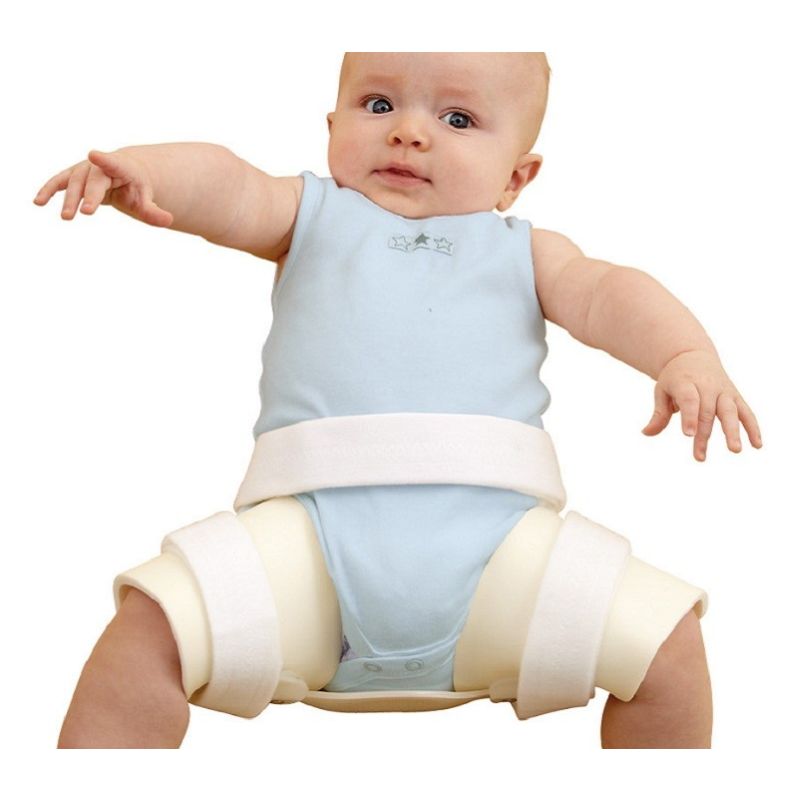

15 - 20 In previous research, we showed that a seating system with medial knee support could act as a fulcrum, thereby accelerating progressive hip displacement in patients with nonambulatory spastic cerebral palsy. Meanwhile, several studies regarding nonsurgical treatment for hip displacement, including various types of hip abduction braces, postural alignment seating systems, and botulinum toxin injection, have reported inconsistent results. 9 Therefore, effective treatment for hip displacement in children with cerebral palsy has mainly focused on surgery. 6, 10 - 13 However, there is conflicting evidence for conservative management to prevent hip displacement in patients with nonambulatory cerebral palsy. Several hip surveillance programs for the early identification of and intervention for children with hips at risk have been established to prevent hip displacement and the need for complex salvage surgery. 4 - 8 Hip displacement may cause pain fixed deformity pelvic obliquity scoliosis loss of ability to sit, stand, and walk and difficulty with dressing, bathing, and perineal care these significantly impact function and quality of life (QOL). 4, 5 Gradual deterioration of MI is seen in these children, from 3.9% per year at Gross Motor Function Classification System (GMFCS) level IV to 9.5% at level V. 1 - 3 Among them, progressive hip displacement (Reimers migration index (MI) >30%-33%) is the second most common musculoskeletal deformity. Many children with cerebral palsy present with various musculoskeletal deformities associated with poor biomechanical alignment during growth.

Hip abduction brace registration#
Trial Registration Identifier: NCT04033289 Therefore, hip brace use could be a promising treatment method to delay hip surgery and improve the quality of life of patients with nonambulatory cerebral palsy. It effectively improved quality of life in patients with nonambulatory cerebral palsy. The changes in the Caregiver Priorities & Child Health Index of Life with Disabilities were favorable in the study group and reached statistical significance at the 6-month follow-up compared with the control group (difference, −14.2 95% CI, −25.2 to −3.3).Ĭonclusions and Relevance In this randomized clinical trial, the novel hip brace was significantly effective in preventing the progression of hip displacement, compared with the control group. The mean difference of the MI between the intervention group and control group was −8.7 (95% CI, −10.2 to −7.1) percentage points at 6 months and −12.7 (95% CI, −14.7 to −10.7) percentage points at 12 months.

The baseline mean (SD) MI was 37.4% (19.3%) in the intervention group and 30.6% (16.3%) in the control group. Results A total of 66 patients were included, with 33 patients (mean age, 68.7 months 25 boys) randomized to the intervention group and 33 patients (mean age, 60.7 months 20 boys) randomized to the control group. Secondary outcomes include change in the Caregiver Priorities & Child Health Index of Life with Disabilities, on which lower scores indicate better quality of life. Primary outcome variables were analyzed using linear mixed models. Main Outcomes and Measures The primary outcome was the Reimers migration index (MI) on radiography, as assessed by 3 blinded investigators. Both groups proceeded with conventional rehabilitation therapy during the trial. Follow-up evaluations were performed after 6 and 12 months of wearing the brace. Interventions The intervention group wore the hip brace for at least 12 hours a day for the study duration (ie, 12 months). Data were analyzed from November to December 2021. Block randomization was used to assign an equal number of patients to the study and control groups via computerized random allocation sequences. Participants included children aged 1 to 10 years with nonambulatory cerebral palsy (Gross Motor Function Classification System level IV or V). Objective To investigate the efficacy of a novel hip brace in preventing progressive hip displacement in patients with cerebral palsy.ĭesign, Setting, and Participants This 2-group randomized clinical trial was conducted at 4 tertiary hospitals in South Korea from July 2019 to November 2021. Importance There is no consensus on interventions to slow the progress of hip displacement in patients with cerebral palsy.


 0 kommentar(er)
0 kommentar(er)
